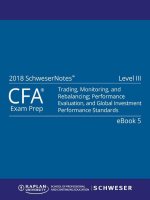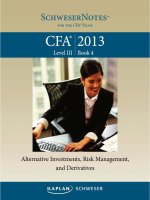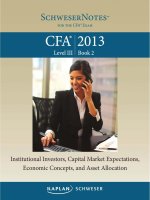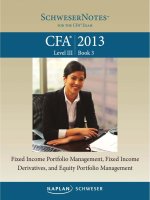2018 CFA level 1 study note book4
Bạn đang xem bản rút gọn của tài liệu. Xem và tải ngay bản đầy đủ của tài liệu tại đây (14.14 MB, 401 trang )
Table of Contents
1.
2.
3.
4.
5.
6.
Getting Started Flyer
Table of Contents
Page List
Book 4: Corporate Finance, Portfolio Management, and Equity Investments
Reading Assignments and Learning Outcome Statements
Corporate Governance and ESG: An Introduction
1. LOS 34.a: Describe corporate governance.
2. LOS 34.b: Describe a company's stakeholder groups and compare interests
of stakeholder groups.
3. LOS 34.c: Describe principal–agent and other relationships in corporate
governance and the conflicts that may arise in these relationships.
4. LOS 34.d: Describe stakeholder management.
5. LOS 34.e: Describe mechanisms to manage stakeholder relationships and
mitigate associated risks.
6. LOS 34.f: Describe functions and responsibilities of a company's board of
directors and its committees.
7. LOS 34.g: Describe market and non-market factors that can affect
stakeholder relationships and corporate governance.
8. LOS 34.h: Identify potential risks of poor corporate governance and
stakeholder management and identify benefits from effective corporate
governance and stakeholder management.
9. LOS 34.i: Describe factors relevant to the analysis of corporate governance
and stakeholder management.
10. LOS 34.j: Describe environmental and social considerations in investment
analysis.
11. LOS 34.k: Describe how environmental, social, and governance factors may
be used in investment analysis.
12. Key Concepts
1. LOS 34.a
2. LOS 34.b
3. LOS 34.c
4. LOS 34.d
5. LOS 34.e
6. LOS 34.f
7. LOS 34.g
8. LOS 34.h
9. LOS 34.i
10. LOS 34.j
11. LOS 34.k
13. Concept Checkers
1. Answers – Concept Checkers
7. Capital Budgeting
1. LOS 35.a: Describe the capital budgeting process and distinguish among the
various categories of capital projects.
2. LOS 35.b: Describe the basic principles of capital budgeting.
3. LOS 35.c: Explain how the evaluation and selection of capital projects is
affected by mutually exclusive projects, project sequencing, and capital
rationing.
4. LOS 35.d: Calculate and interpret net present value (NPV), internal rate of
return (IRR), payback period, discounted payback period, and profitability
index (PI) of a single capital project.
5. LOS 35.e: Explain the NPV profile, compare the NPV and IRR methods when
evaluating independent and mutually exclusive projects, and describe the
problems associated with each of the evaluation methods.
6. LOS 35.f: Describe expected relations among an investment's NPV,
company value, and share price.
7. Key Concepts
1. LOS 35.a
2. LOS 35.b
3. LOS 35.c
4. LOS 35.d
5. LOS 35.e
6. LOS 35.f
8. Concept Checkers
1. Answers – Concept Checkers
8. Cost of Capital
1. LOS 36.a: Calculate and interpret the weighted average cost of capital
(WACC) of a company.
2. LOS 36.b: Describe how taxes affect the cost of capital from different
capital sources.
3. LOS 36.c: Describe the use of target capital structure in estimating WACC
and how target capital structure weights may be determined.
4. LOS 36.d: Explain how the marginal cost of capital and the investment
opportunity schedule are used to determine the optimal capital budget.
5. LOS 36.e: Explain the marginal cost of capital's role in determining the net
present value of a project.
6. LOS 36.f: Calculate and interpret the cost of debt capital using the yield-tomaturity approach and the debt-rating approach.
7. LOS 36.g: Calculate and interpret the cost of noncallable, nonconvertible
preferred stock.
8. LOS 36.h: Calculate and interpret the cost of equity capital using the capital
asset pricing model approach, the dividend discount model approach, and
the bond-yield-plus risk-premium approach.
9. LOS 36.i: Calculate and interpret the beta and cost of capital for a project.
10. LOS 36.j: Describe uses of country risk premiums in estimating the cost of
equity.
11. LOS 36.k: Describe the marginal cost of capital schedule, explain why it may
be upward-sloping with respect to additional capital, and calculate and
interpret its break-points.
12. LOS 36.l: Explain and demonstrate the correct treatment of flotation costs.
13. Key Concepts
1. LOS 36.a
2. LOS 36.b
3. LOS 36.c
4. LOS 36.d
5. LOS 36.e
6. LOS 36.f
7. LOS 36.g
8. LOS 36.h
9. LOS 36.i
10. LOS 36.j
11. LOS 36.k
12. LOS 36.l
14. Concept Checkers
1. Answers – Concept Checkers
9. Measures of Leverage
1. LOS 37.a: Define and explain leverage, business risk, sales risk, operating
risk, and financial risk and classify a risk.
2. LOS 37.b: Calculate and interpret the degree of operating leverage, the
degree of financial leverage, and the degree of total leverage.
3. LOS 37.c: Analyze the effect of financial leverage on a company's net
income and return on equity.
4. LOS 37.d: Calculate the breakeven quantity of sales and determine the
company's net income at various sales levels.
5. LOS 37.e: Calculate and interpret the operating breakeven quantity of
sales.
6. Key Concepts
1. LOS 37.a
2. LOS 37.b
3. LOS 37.c
4. LOS 37.d
5. LOS 37.e
7. Concept Checkers
1. Answers – Concept Checkers
10. Working Capital Management
1. LOS 38.a: Describe primary and secondary sources of liquidity and factors
that influence a company's liquidity position.
2. LOS 38.b: Compare a company's liquidity measures with those of peer
companies.
3. LOS 38.c: Evaluate working capital effectiveness of a company based on its
operating and cash conversion cycles and compare the company's
effectiveness with that of peer companies.
4. LOS 38.d: Describe how different types of cash flows affect a company's net
daily cash position.
5. LOS 38.e: Calculate and interpret comparable yields on various securities,
compare portfolio returns against a standard benchmark, and evaluate a
company's short-term investment policy guidelines.
6. LOS 38.f: Evaluate a company's management of accounts receivable,
inventory, and accounts payable over time and compared to peer
companies.
7. LOS 38.g: Evaluate the choices of short-term funding available to a
company and recommend a financing method.
8. Key Concepts
1. LOS 38.a
2. LOS 38.b
3. LOS 38.c
4. LOS 38.d
5. LOS 38.e
6. LOS 38.f
7. LOS 38.g
9. Concept Checkers
1. Answers – Concept Checkers
11. Self-Test Assessment: Corporate Finance
1. Self-Test Assessment Answers: Corporate Finance
12. Portfolio Management: An Overview
1. LOS 39.a: Describe the portfolio approach to investing.
2. LOS 39.b: Describe types of investors and distinctive characteristics and
needs of each.
3. LOS 39.c: Describe defined contribution and defined benefit pension plans.
4. LOS 39.d: Describe the steps in the portfolio management process.
5. LOS 39.e: Describe mutual funds and compare them with other pooled
investment products.
6. Key Concepts
1. LOS 39.a
2. LOS 39.b
3. LOS 39.c
4. LOS 39.d
5. LOS 39.e
7. Concept Checkers
1. Answers – Concept Checkers
13. Risk Management: An Introduction
1. LOS 40.a: Define risk management.
2. LOS 40.b: Describe features of a risk management framework.
3. LOS 40.c: Define risk governance and describe elements of effective risk
governance.
4. LOS 40.d: Explain how risk tolerance affects risk management.
5. LOS 40.e: Describe risk budgeting and its role in risk governance.
6. LOS 40.f: Identify financial and non-financial sources of risk and describe
how they may interact.
7. LOS 40.g: Describe methods for measuring and modifying risk exposures
and factors to consider in choosing among the methods.
8. Key Concepts
1. LOS 40.a
2. LOS 40.b
3. LOS 40.c
4. LOS 40.d
5. LOS 40.e
6. LOS 40.f
7. LOS 40.g
9. Concept Checkers
1. Answers – Concept Checkers
14. Portfolio Risk and Return: Part I
1. LOS 41.a: Calculate and interpret major return measures and describe their
appropriate uses.
2. LOS 41.b: Describe characteristics of the major asset classes that investors
consider in forming portfolios.
3. LOS 41.c: Calculate and interpret the mean, variance, and covariance (or
correlation) of asset returns based on historical data.
4. LOS 41.d: Explain risk aversion and its implications for portfolio selection.
5. LOS 41.e: Calculate and interpret portfolio standard deviation.
6. LOS 41.f: Describe the effect on a portfolio's risk of investing in assets that
are less than perfectly correlated.
7. LOS 41.g: Describe and interpret the minimum-variance and efficient
frontiers of risky assets and the global minimum-variance portfolio.
8. LOS 41.h: Explain the selection of an optimal portfolio, given an investor's
utility (or risk aversion) and the capital allocation line.
9. Key Concepts
1. LOS 41.a
2. LOS 41.b
3. LOS 41.c
4. LOS 41.d
5. LOS 41.e
6. LOS 41.f
7. LOS 41.g
8. LOS 41.h
10. Concept Checkers
1. Answers – Concept Checkers
15. Portfolio Risk and Return: Part II
1. LOS 42.a: Describe the implications of combining a risk-free asset with a
portfolio of risky assets.
2. LOS 42.b: Explain the capital allocation line (CAL) and the capital market
line (CML).
3. LOS 42.c: Explain systematic and nonsystematic risk, including why an
investor should not expect to receive additional return for bearing
nonsystematic risk.
4. LOS 42.d: Explain return generating models (including the market model)
and their uses.
5. LOS 42.e: Calculate and interpret beta.
6. LOS 42.f: Explain the capital asset pricing model (CAPM), including its
assumptions, and the security market line (SML).
7. LOS 42.g: Calculate and interpret the expected return of an asset using the
CAPM.
8. LOS 42.h: Describe and demonstrate applications of the CAPM and the
SML.
9. LOS 42.i: Calculate and interpret the Sharpe ratio, Treynor ratio, M2, and
Jensen's alpha.
10. Key Concepts
1. LOS 42.a
2. LOS 42.b
3. LOS 42.c
4. LOS 42.d
5. LOS 42.e
6. LOS 42.f
7. LOS 42.g
8. LOS 42.h
9. LOS 42.i
11. Concept Checkers
1. Answers – Concept Checkers
16. Basics of Portfolio Planning and Construction
1. LOS 43.a: Describe the reasons for a written investment policy statement
(IPS).
2. LOS 43.b: Describe the major components of an IPS.
3. LOS 43.c: Describe risk and return objectives and how they may be
developed for a client.
4. LOS 43.d: Distinguish between the willingness and the ability (capacity) to
take risk in analyzing an investor's financial risk tolerance.
5. LOS 43.e: Describe the investment constraints of liquidity, time horizon, tax
concerns, legal and regulatory factors, and unique circumstances and their
implications for the choice of portfolio assets.
6. LOS 43.f: Explain the specification of asset classes in relation to asset
allocation.
7. LOS 43.g: Describe the principles of portfolio construction and the role of
asset allocation in relation to the IPS.
8. Key Concepts
1. LOS 43.a
2. LOS 43.b
3. LOS 43.c
4. LOS 43.d
5. LOS 43.e
6. LOS 43.f
7. LOS 43.g
9. Concept Checkers
1. Answers – Concept Checkers
17. Self-Test Assessment: Portfolio Management
1. Self-Test Assessment Answers: Portfolio Management
18. Market Organization and Structure
1. LOS 44.a: Explain the main functions of the financial system.
2. LOS 44.b: Describe classifications of assets and markets.
3. LOS 44.c: Describe the major types of securities, currencies, contracts,
commodities, and real assets that trade in organized markets, including
their distinguishing characteristics and major subtypes.
4. LOS 44.d: Describe types of financial intermediaries and services that they
provide.
5. LOS 44.e: Compare positions an investor can take in an asset.
6. LOS 44.f: Calculate and interpret the leverage ratio, the rate of return on a
margin transaction, and the security price at which the investor would
receive a margin call.
7. LOS 44.g: Compare execution, validity, and clearing instructions.
8. LOS 44.h: Compare market orders with limit orders.
9. LOS 44.i: Define primary and secondary markets and explain how
secondary markets support primary markets.
10. LOS 44.j: Describe how securities, contracts, and currencies are traded in
quote-driven, order-driven, and brokered markets.
11. LOS 44.k: Describe characteristics of a well-functioning financial system.
12. LOS 44.l: Describe objectives of market regulation.
13. Key Concepts
1. LOS 44.a
2. LOS 44.b
3. LOS 44.c
4. LOS 44.d
5. LOS 44.e
6. LOS 44.f
7. LOS 44.g
8. LOS 44.h
9. LOS 44.i
10. LOS 44.j
11. LOS 44.k
12. LOS 44.l
14. Concept Checkers
1. Answers – Concept Checkers
19. Security Market Indexes
1. LOS 45.a: Describe a security market index.
2. LOS 45.b: Calculate and interpret the value, price return, and total return of
an index.
3. LOS 45.c: Describe the choices and issues in index construction and
management.
4. LOS 45.d: Compare the different weighting methods used in index
construction.
5. LOS 45.e: Calculate and analyze the value and return of an index given its
weighting method.
6. LOS 45.f: Describe rebalancing and reconstitution of an index.
7. LOS 45.g: Describe uses of security market indexes.
8. LOS 45.h: Describe types of equity indexes.
9. LOS 45.i: Describe types of fixed-income indexes.
10. LOS 45.j: Describe indexes representing alternative investments.
11. LOS 45.k: Compare types of security market indexes.
12. Key Concepts
1. LOS 45.a
2. LOS 45.b
3. LOS 45.c
4. LOS 45.d
5. LOS 45.e
6. LOS 45.f
7. LOS 45.g
8. LOS 45.h
9. LOS 45.i
10. LOS 45.j
11. LOS 45.k
13. Concept Checkers
1. Answers – Concept Checkers
20. Market Efficiency
1. LOS 46.a: Describe market efficiency and related concepts, including their
importance to investment practitioners.
2. LOS 46.b: Distinguish between market value and intrinsic value.
3. LOS 46.c: Explain factors that affect a market's efficiency.
4. LOS 46.d: Contrast weak-form, semi-strong-form, and strong-form market
efficiency.
5. LOS 46.e: Explain the implications of each form of market efficiency for
fundamental analysis, technical analysis, and the choice between active
and passive portfolio management.
6. LOS 46.f: Describe market anomalies.
7. LOS 46.g: Describe behavioral finance and its potential relevance to
understanding market anomalies.
8. Key Concepts
1. LOS 46.a
2. LOS 46.b
3. LOS 46.c
4. LOS 46.d
5. LOS 46.e
6. LOS 46.f
7. LOS 46.g
9. Concept Checkers
1. Answers – Concept Checkers
21. Overview of Equity Securities
1. LOS 47.a: Describe characteristics of types of equity securities.
2. LOS 47.b: Describe differences in voting rights and other ownership
characteristics among different equity classes.
3. LOS 47.c: Distinguish between public and private equity securities.
4. LOS 47.d: Describe methods for investing in non-domestic equity securities.
5. LOS 47.e: Compare the risk and return characteristics of different types of
equity securities.
6. LOS 47.f: Explain the role of equity securities in the financing of a
company's assets.
7. LOS 47.g: Distinguish between the market value and book value of equity
securities.
8. LOS 47.h: Compare a company's cost of equity, its (accounting) return on
equity, and investors' required rates of return.
9. Key Concepts
1. LOS 47.a
2. LOS 47.b
3. LOS 47.c
4. LOS 47.d
5. LOS 47.e
6. LOS 47.f
7. LOS 47.g
8. LOS 47.h
10. Concept Checkers
1. Answers – Concept Checkers
22. Introduction to Industry and Company Analysis
1. LOS 48.a: Explain uses of industry analysis and the relation of industry
analysis to company analysis.
2. LOS 48.b: Compare methods by which companies can be grouped, current
industry classification systems, and classify a company, given a description
of its activities and the classification system.
3. LOS 48.c: Explain the factors that affect the sensitivity of a company to the
business cycle and the uses and limitations of industry and company
descriptors such as “growth,” “defensive,” and “cyclical.”
4. LOS 48.d: Explain how a company's industry classification can be used to
identify a potential “peer group” for equity valuation.
5. LOS 48.e: Describe the elements that need to be covered in a thorough
industry analysis.
6. LOS 48.f: Describe the principles of strategic analysis of an industry.
7. LOS 48.g: Explain the effects of barriers to entry, industry concentration,
industry capacity, and market share stability on pricing power and price
competition.
8. LOS 48.h: Describe industry life cycle models, classify an industry as to life
cycle stage, and describe limitations of the life-cycle concept in forecasting
industry performance.
9. LOS 48.i: Compare characteristics of representative industries from the
various economic sectors.
10. LOS 48.j: Describe macroeconomic, technological, demographic,
governmental, and social influences on industry growth, profitability, and
risk.
11. LOS 48.k: Describe the elements that should be covered in a thorough
company analysis.
12. Key Concepts
1. LOS 48.a
2. LOS 48.b
3. LOS 48.c
4. LOS 48.d
5. LOS 48.e
6. LOS 48.f
7. LOS 48.g
8. LOS 48.h
9. LOS 48.i
10. LOS 48.j
11. LOS 48.k
13. Concept Checkers
1. Answers – Concept Checkers
23. Equity Valuation: Concepts and Basic Tools
1. LOS 49.a: Evaluate whether a security, given its current market price and a
value estimate, is overvalued, fairly valued, or undervalued by the market.
2. LOS 49.b: Describe major categories of equity valuation models.
3. LOS 49.c: Describe regular cash dividends, extra dividends, liquidating
dividends, stock dividends, stock splits, and reverse stock splits, including
their expected effect on shareholders' wealth and a company's financial
ratios.
4. LOS 49.d: Describe dividend payment chronology.
5. LOS 49.e: Explain the rationale for using present value models to value
equity and describe the dividend discount and free-cash-flow-to-equity
models.
6. LOS 49.f: Calculate the intrinsic value of a non-callable, non-convertible
preferred stock.
7. LOS 49.g: Calculate and interpret the intrinsic value of an equity security
based on the Gordon (constant) growth dividend discount model or a twostage dividend discount model, as appropriate.
8. LOS 49.h: Identify characteristics of companies for which the constant
growth or a multistage dividend discount model is appropriate.
9. LOS 49.i: Explain the rationale for using price multiples to value equity, how
the price to earnings multiple relates to fundamentals, and the use of
multiples based on comparables.
10. LOS 49.j: Calculate and interpret the following multiples: price to earnings,
price to an estimate of operating cash flow, price to sales, and price to
book value.
11. LOS 49.k: Describe enterprise value multiples and their use in estimating
equity value.
12. LOS 49.l: Describe asset-based valuation models and their use in estimating
equity value.
13. LOS 49.m: Explain advantages and disadvantages of each category of
valuation model.
14. Key Concepts
1. LOS 49.a
2. LOS 49.b
3. LOS 49.c
4. LOS 49.d
5. LOS 49.e
6. LOS 49.f
7. LOS 49.g
8. LOS 49.h
9. LOS 49.i
10. LOS 49.j
11. LOS 49.k
12. LOS 49.l
13. LOS 49.m
15. Concept Checkers
1. Answers – Concept Checkers
24. Self-Test Assessment: Equity Investments
1. Self-Test Assessment Answers: Equity Investments
25. Formulas
26. Copyright
Page List
1.
2.
3.
4.
5.
6.
7.
8.
9.
10.
11.
12.
13.
14.
15.
16.
17.
18.
19.
20.
21.
22.
23.
24.
25.
26.
27.
28.
29.
30.
31.
32.
33.
34.
35.
36.
37.
38.
i
iii
iv
v
vi
vii
viii
ix
x
xi
xii
xiii
1
2
3
4
5
6
7
8
9
10
11
12
13
14
15
16
17
18
19
20
21
22
23
24
25
26
39.
40.
41.
42.
43.
44.
45.
46.
47.
48.
49.
50.
51.
52.
53.
54.
55.
56.
57.
58.
59.
60.
61.
62.
63.
64.
65.
66.
67.
68.
69.
70.
71.
72.
73.
74.
75.
76.
77.
78.
79.
80.
81.
82.
27
28
29
30
31
32
33
34
35
36
37
38
39
40
41
42
43
44
45
46
47
48
49
50
51
52
53
54
55
56
57
58
59
60
61
62
63
64
65
66
67
68
69
70
83.
84.
85.
86.
87.
88.
89.
90.
91.
92.
93.
94.
95.
96.
97.
98.
99.
100.
101.
102.
103.
104.
105.
106.
107.
108.
109.
110.
111.
112.
113.
114.
115.
116.
117.
118.
119.
120.
121.
122.
123.
124.
125.
126.
71
72
73
74
75
76
77
78
79
80
81
82
83
84
85
86
87
88
89
90
91
92
93
94
95
96
97
98
99
100
101
102
103
104
105
106
107
108
109
110
111
112
113
114
127.
128.
129.
130.
131.
132.
133.
134.
135.
136.
137.
138.
139.
140.
141.
142.
143.
144.
145.
146.
147.
148.
149.
150.
151.
152.
153.
154.
155.
156.
157.
158.
159.
160.
161.
162.
163.
164.
165.
166.
167.
168.
169.
170.
115
116
117
118
119
120
121
122
123
124
125
126
127
128
129
130
131
132
133
134
135
136
137
138
139
140
141
142
143
144
145
146
147
148
149
150
151
152
153
154
155
156
157
158
171.
172.
173.
174.
175.
176.
177.
178.
179.
180.
181.
182.
183.
184.
185.
186.
187.
188.
189.
190.
191.
192.
193.
194.
195.
196.
197.
198.
199.
200.
201.
202.
203.
204.
205.
206.
207.
208.
209.
210.
211.
212.
213.
214.
159
160
161
162
163
164
165
166
167
168
169
170
171
172
173
174
175
176
177
178
179
180
181
182
183
184
185
186
187
188
189
190
191
192
193
194
195
196
197
198
199
200
201
202
215.
216.
217.
218.
219.
220.
221.
222.
223.
224.
225.
226.
227.
228.
229.
230.
231.
232.
233.
234.
235.
236.
237.
238.
239.
240.
241.
242.
243.
244.
245.
246.
247.
248.
249.
250.
251.
252.
253.
254.
255.
256.
257.
258.
203
204
205
206
207
208
209
210
211
212
213
214
215
216
217
218
219
220
221
222
223
224
225
226
227
228
229
230
231
232
233
234
235
236
237
238
239
240
241
242
243
244
245
246
259.
260.
261.
262.
263.
264.
265.
266.
267.
268.
269.
270.
271.
272.
273.
274.
275.
276.
277.
278.
279.
280.
281.
282.
283.
284.
285.
286.
287.
288.
289.
290.
291.
292.
293.
294.
295.
296.
297.
298.
299.
300.
301.
302.
247
248
249
250
251
252
253
254
255
256
257
258
259
260
261
262
263
264
265
266
267
268
269
270
271
272
273
274
275
276
277
278
279
280
281
282
283
284
285
286
287
288
289
290
303.
304.
305.
306.
307.
308.
309.
310.
311.
312.
313.
314.
315.
316.
317.
318.
319.
320.
321.
322.
323.
324.
325.
326.
327.
328.
329.
330.
331.
332.
333.
334.
335.
336.
291
292
293
294
295
296
297
298
299
300
301
302
303
304
305
306
307
308
309
310
311
312
313
314
315
316
317
318
319
320
321
322
323
324
BOOK 4 – CORPORATE FINANCE, PORTFOLIO
MANAGEMENT, AND EQUITY INVESTMENTS
Reading Assignments and Learning Outcome Statements
Study Session 10 – Corporate Finance: Corporate Governance, Capital Budgeting,
and Cost of Capital
Study Session 11 – Corporate Finance: Leverage and Working Capital Management
Self-Test Assessment: Corporate Finance
Study Session 12 – Portfolio Management
Self-Test Assessment: Portfolio Management
Study Session 13 – Equity Market Organization, Market Indexes, and Market
Efficiency
Study Session 14 – Equity Analysis and Valuation
Self-Test Assessment: Equity Investments
Formulas
READING ASSIGNMENTS AND LEARNING OUTCOME
STATEMENTS
The following material is a review of the Corporate Finance, Portfolio Management,
and Equity Investments principles designed to address the learning outcome
statements set forth by CFA Institute.
STUDY SESSION 10
Reading Assignments
Corporate Finance and Portfolio Management, CFA Program Level I 2018
Curriculum
(CFA Institute, 2017)
34. Corporate Governance and ESG: An Introduction
35. Capital Budgeting
36. Cost of Capital
STUDY SESSION 11
Reading Assignments
Corporate Finance and Portfolio Management, CFA Program Level I 2018
Curriculum
(CFA Institute, 2017)
37. Measures of Leverage
38. Working Capital Management
STUDY SESSION 12
Reading Assignments
Corporate Finance and Portfolio Management, CFA Program Level I 2018
Curriculum
(CFA Institute, 2017)
39. Portfolio Management: An Overview
40. Risk Management: An Introduction
41. Portfolio Risk and Return: Part I
42. Portfolio Risk and Return: Part II
43. Basics of Portfolio Planning and Construction
STUDY SESSION 13
Reading Assignments
Equity and Fixed Income, CFA Program Level I 2018 Curriculum
(CFA Institute, 2017)
44. Market Organization and Structure
45. Security Market Indexes
46. Market Efficiency
STUDY SESSION 14
Reading Assignments
Equity and Fixed Income, CFA Program Level I 2018 Curriculum
(CFA Institute, 2017)
47. Overview of Equity Securities
48. Introduction to Industry and Company Analysis
49. Equity Valuation: Concepts and Basic Tools
LEARNING OUTCOME STATEMENTS (LOS)
STUDY SESSION 10
The topical coverage corresponds with the following CFA Institute assigned
reading:
34. Corporate Governance and ESG: An Introduction
The candidate should be able to:
a. describe corporate governance. (page 1)
b. describe a company’s stakeholder groups and compare interests of
stakeholder groups. (page 2)
c. describe principal–agent and other relationships in corporate governance
and the conflicts that may arise in these relationships. (page 3)
d. describe stakeholder management. (page 4)
e. describe mechanisms to manage stakeholder relationships and mitigate
associated risks. (page 4)
f. describe functions and responsibilities of a company’s board of directors and
its committees. (page 5)
g. describe market and non-market factors that can affect stakeholder
relationships and corporate governance. (page 7)
h. identify potential risks of poor corporate governance and stakeholder
management and identify benefits from effective corporate governance
and stakeholder management. (page 9)
i. describe factors relevant to the analysis of corporate governance and
stakeholder management. (page 9)
j. describe environmental and social considerations in investment analysis.
(page 11)
k. describe how environmental, social, and governance factors may be used in
investment analysis. (page 12)
The topical coverage corresponds with the following CFA Institute assigned
reading:
35. Capital Budgeting
The candidate should be able to:
a. describe the capital budgeting process and distinguish among the various
categories of capital projects. (page 18)
b. describe the basic principles of capital budgeting. (page 19)
c. explain how the evaluation and selection of capital projects is affected by
mutually exclusive projects, project sequencing, and capital rationing.
(page 21)
d. calculate and interpret net present value (NPV), internal rate of return (IRR),
payback period, discounted payback period, and profitability index (PI) of a
single capital project. (page 21)
e. explain the NPV profile, compare the NPV and IRR methods when evaluating
independent and mutually exclusive projects, and describe the problems
associated with each of the evaluation methods. (page 29)
f. describe expected relations among an investment’s NPV, company value,
and share price. (page 32)
The topical coverage corresponds with the following CFA Institute assigned
reading:
36. Cost of Capital
The candidate should be able to:
a. calculate and interpret the weighted average cost of capital (WACC) of a
company. (page 41)
b. describe how taxes affect the cost of capital from different capital sources.
(page 41)
c. describe the use of target capital structure in estimating WACC and how
target capital structure weights may be determined. (page 43)









